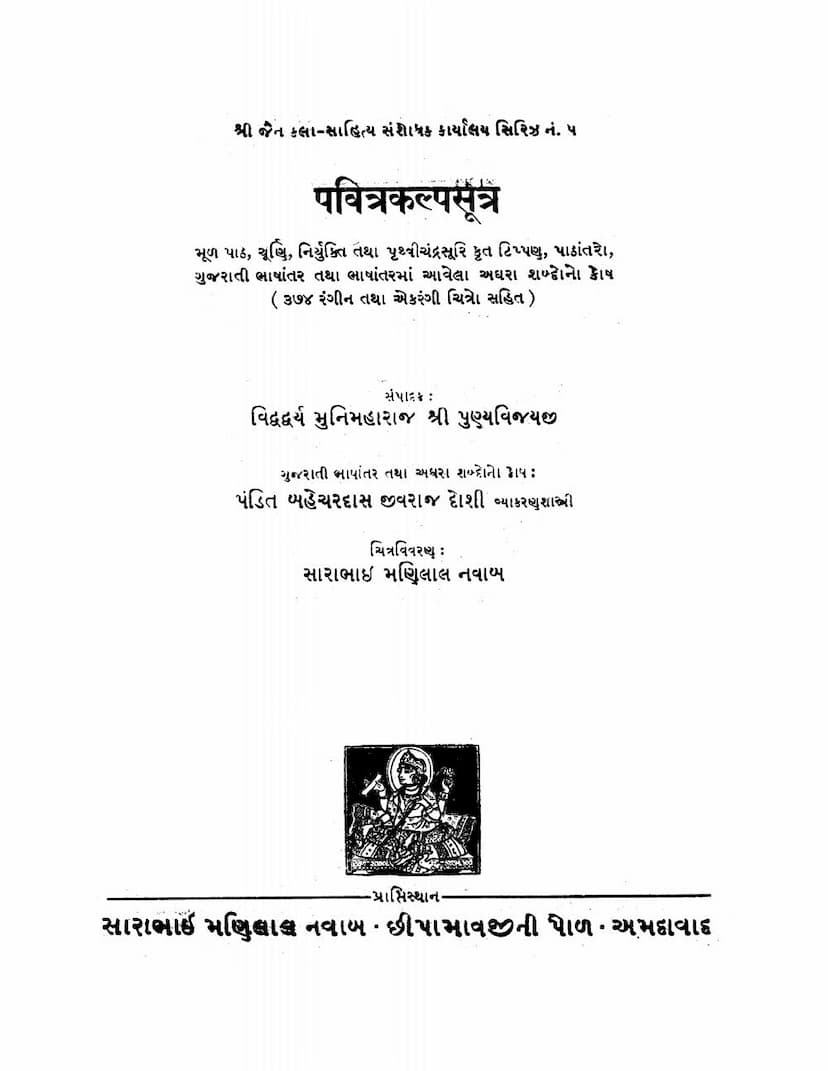Pavitra Kalpasutra
Added to library: September 2, 2025

Summary
This Jain text, Pavitra Kalpasutra (Sacred Kalpasutra), is a significant work published by Sarabhai Manilal Nawab. The book, presented in Gujarati, is a comprehensive exploration of the Kalpasutra, a fundamental scripture in Svetambara Jainism.
Key Features and Contents:
- Original Text: The book includes the original Sanskrit text of the Kalpasutra.
- Commentaries: It features the Churni (a primary commentary), the Niryukti (a meta-commentary), and the Tippanaka (a detailed annotation) by Prithvichandrasuri.
- Variant Readings: The text incorporates different readings of the original scripture.
- Gujarati Translation: A complete Gujarati translation of the Kalpasutra is provided.
- Glossary: A glossary of difficult words found in the Gujarati translation is included.
- Illustrations: The book is enriched with 374 illustrations, both in color and monochrome, providing visual insights into Jain art and history.
- Editors and Contributors:
- Edited by Vidvadvara Muni Shri Punyavijayji.
- Gujarati translation and glossary of difficult words by Pandit Bechardas Jivraj Doshi, a grammarian.
- Description of illustrations by Sarabhai Manilal Nawab.
Content Overview from the Preface and Descriptions:
The preface, penned by Sarabhai Manilal Nawab, highlights his extensive work in documenting Jain illustrated manuscripts, particularly focusing on the Kalpasutra and Kalakatha. He mentions his previous works like "Jain Chitra-Kalpadrum" (1936), "Jain Chitra-Kalpalata" (1940), "Shri Chitra-Kalpasutra" (1941), and others. This current publication aims to present a significant portion of the Kalpasutra illustrations for the first time.
The text details the history of Jain manuscript art from Western India, primarily from Kalpasutra and Kalakatha manuscripts, which are predominantly found in the Shvetambara Jain tradition. The illustrations span from the 10th century (based on script dating) to the 16th century, showcasing the evolution of Jain art on palm-leaf and paper manuscripts.
Nawab further explains the categorization of palm-leaf manuscript art into two periods:
- First Period (Vikram Samvat 111 to 1356 / approx. 54 AD to 1299 AD): This period includes the oldest palm-leaf manuscripts, with the oldest text-only copy of Visheshavashyak Bhashya from the 10th century found in the Jinabhadraturi Jnana Bhandar in Jaisalmer. The oldest illustrated manuscripts with figures date back to the Shri Bhagavati Sutra from the Jinabhadraturi Jnana Bhandar, written in VS 1111 (1053-1062 AD), containing six figures. The period from VS 1157 (1099 AD) onwards, starting with Nishithi Churni, shows further illustrated examples.
- Second Period (Vikram Samvat 1357 to 1456 / 1300 to 1399 AD): This period marks the beginning of palm-leaf manuscript illustrations in Gujarat, with dated palm-leaf manuscripts appearing from VS 1418 (1361 AD) onwards. Many beautiful illustrations from this period are cited from various collections.
The book also discusses Jain art on paper manuscripts, dating from VS 1403 (1346 AD) to 1556 (1499 AD), citing several important Kalpasutra and Kalakatha manuscripts with their dates and locations.
The latter part of the preface delves into scholarly discussions about the original language and text of the Kalpasutra, addressing variations in manuscripts and the challenges of textual criticism. It also touches upon the linguistic nuances of Prakrit in Jain Agamas and the influence of scribal errors and regional variations.
The detailed "Illustration Descriptions" section meticulously explains each of the 374 illustrations, providing context, identifying figures, describing the artistic style, and referencing the specific manuscript from which it was taken. These descriptions offer a rich historical and cultural understanding of Jain miniature painting.
Overall Significance:
Pavitra Kalpasutra is a monumental work that serves as both a scholarly resource and an aesthetic treasure. It offers deep insights into the Kalpasutra text, its commentaries, and, most notably, its rich tradition of miniature painting from Western India, a vital part of Jain heritage. The dedication of the book to the author's late parents highlights the personal and cultural significance of this endeavor in preserving and presenting ancient Jain art and literature. The limited edition of 250 copies and the premium binding options suggest its value as a collector's item as well.